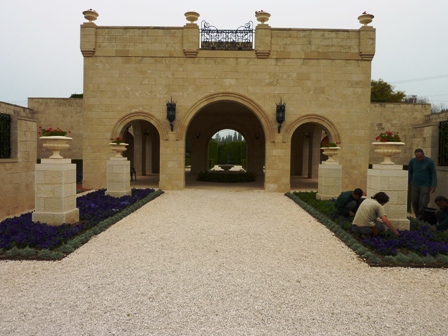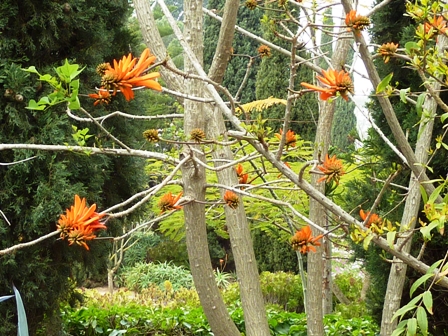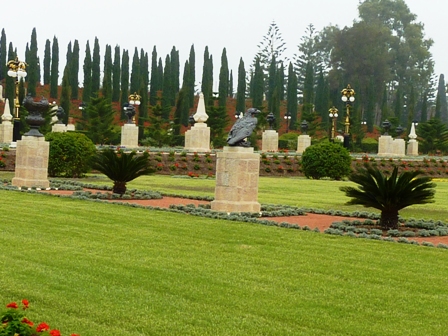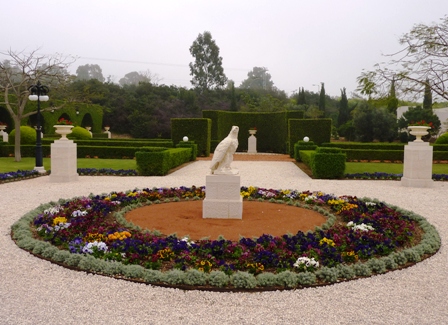 The Baha’i Gardens in Israel, one in Haifa and the other in Akko, are a reflection of the profound beauty of the Baha’i faith, founded in nineteenth century Persia by Mirza Husaayn Ali Nuri, later known as BahaUllah. The Baha’i faith believes that religious history has been led by a series of divine messengers, each of whom has founded a religion that can be responded to by the people of those times: this includes Abraham, Buddha, Jesus, Muhammad and, most recently, the Bab and Bahaullah. The Baha’i faith believes in the collective evolution of the world with a focus on creating peace, justice and unity throughout the world.
The Baha’i Gardens in Israel, one in Haifa and the other in Akko, are a reflection of the profound beauty of the Baha’i faith, founded in nineteenth century Persia by Mirza Husaayn Ali Nuri, later known as BahaUllah. The Baha’i faith believes that religious history has been led by a series of divine messengers, each of whom has founded a religion that can be responded to by the people of those times: this includes Abraham, Buddha, Jesus, Muhammad and, most recently, the Bab and Bahaullah. The Baha’i faith believes in the collective evolution of the world with a focus on creating peace, justice and unity throughout the world.
Although I have been to the garden in Haifa, I didn’t know what to expect from the one in Akko: except that it would offer a place of contemplation and peace.
After entering the archway and portico, on both sides of the gravel pathway rectangular beds edged with santolina are filled with annuals, tended to by a group of men: all followers of the Baha’i faith. Several yards further on is a large circle , surrounded by evergreen walls and hedges, punctuated by cypresses.
The gardens that surround the historic mansion, where Bahaullah the founder of Baha’ i lived during his later years, form a large circle. The mansion houses the shrine where Bahaullah’s remains are. It was fascinating and heartwarming to see groups of people from all over the world, coming to pay tribute to their deceased leader. Beyond the circle, a long, straight path, framed with cypress trees is filled with informal plantings, such as hibiscus and aloes. Below is an Erythrina in the beginning of its spring bloom.
A bit more information on the gardens:
“With over half a million visitors a year, the Baha’í Gardens in Haifa and Akko are among the most popular sites in the Middle East. Their unique design, combining geometrical shapes and exquisite detailing with loving conservation of natural and historic landscape features, leaves an indelible impression on visitors. Many return again and again to experience the changing seasons and relive the serene tranquility and uplifting spirit of these special places.
In July 2008, the Bahá’í Gardens in Haifa and ‘Akko were inscribed on UNESCO’s World Heritage List, in recognition of their “outstanding universal value” as holy places and places of pilgrimage for the followers of the Bahá’í Faith.
Like all great works of art, these extraordinary sites are tangible expressions of the human spirit. Here the impetus was not the creativity of a great artist, but rather the loving labor and sacrifice of many people from diverse origins and several generations, inspired by a common faith and an optimistic vision of our collective future.” ( reprinted from the home page of the Baha’i Gardens).
 While walking the garden, I was overwhelmed by the expansive geometry of it. There is a strong Moorish influence here. I couldn’t help but to think that the garden rooms at Hidcote and Sissinghurst in England might have been inspired by this garden. In a funky kind of twist, the annual plantings, consisting of a preponderance of impatiens, allysum and pansies, invoke a feeling of Versailles (which Andre Le Notre created during the reign of Louis XIV).
While walking the garden, I was overwhelmed by the expansive geometry of it. There is a strong Moorish influence here. I couldn’t help but to think that the garden rooms at Hidcote and Sissinghurst in England might have been inspired by this garden. In a funky kind of twist, the annual plantings, consisting of a preponderance of impatiens, allysum and pansies, invoke a feeling of Versailles (which Andre Le Notre created during the reign of Louis XIV).
As I veered to the right, my eye was overtaken by a more naturalized garden that was roped off to the public. Filled with a sweep of aeoniums, sprinkled with several aloes in bloom and fronted with masses of bouganevillea, it was quite a contrast to the majority of the landscape.
Because it was going to be a day of visiting 4 or 5 gardens, with The Baha’i Garden being the first stop, unfortunately, my time was cut short. This is not a garden to be rushed through: rather, it is a garden that needs to be savored at a slow pace in order to experience the full richness and spirit of the place.

